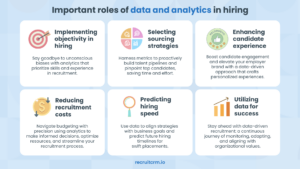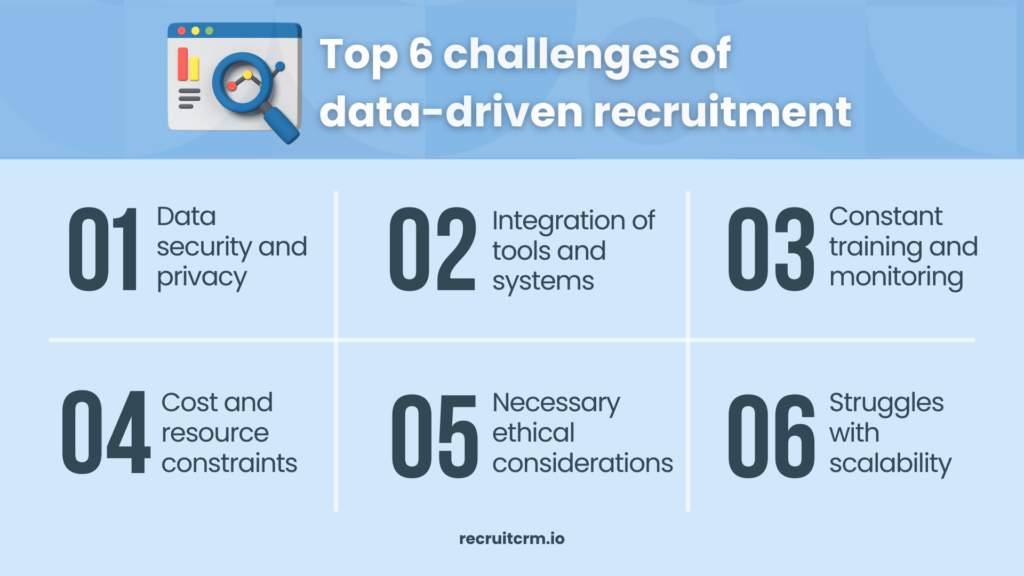In recruitment, staying ahead is no longer just an advantage, it’s a necessity.
If you find yourself grappling to pinpoint the areas in your hiring strategy that need refinement, it’s time to turn your attention to data-driven recruitment.
Why, you ask?
Because it’s the linchpin that can elevate your recruiting game to unprecedented heights.
In this guide, we’re exploring the transformative power of data in recruitment. Let’s dive in.
What is data-driven recruitment?
Data-driven recruitment is a modern approach to hiring where recruiters utilize data and analytics gathered from various sources to make informed, strategic decisions throughout the hiring process.
This method allows for a more proactive and efficient recruitment strategy, helping to identify the best candidates, optimize job descriptions, and align recruitment efforts with organizational goals.
It’s about replacing guesswork with insights for proactive hiring, making the recruitment process not only smoother but significantly more effective.
Here’s how it helps:
1. Making informed hiring decisions
With data-driven recruitment, you get to analyze a range of metrics to boost performance in all aspects of recruiting.
For example, you can assess resume keywords and social media activities to get deep insights into candidates’ skills or even monitor online engagement and market trends to craft informed and targeted hiring strategies, etc.
It helps you understand which channels are most effective and how to tailor job descriptions to attract the right candidates.
2. Alignment with the goals
Data-driven recruitment serves as a blueprint for your hiring strategy, aligning it closely with organizational goals and the pulse of the market trends.
It’s about crafting a strategy that not only fills gaps but builds a team that embodies the diversity and skill set the organization needs.
3. Leveraging tools and technologies
In data-driven recruitment, applicant tracking systems (ATS) like Recruit CRM streamline candidate management, while AI screening tools such as Ideal and Harver automate initial assessments.
Also, analytics platforms like Tableau offer a comprehensive view of market trends, aiding recruiters in making informed decisions. These technologies collectively provide actionable insights, revolutionizing recruitment choices and strategies.
6 important roles of data and analytics in recruitment

1. Implementing objectivity in hiring
Sometimes, biases can find their way into the recruitment process. But here’s the kicker: analytics are here to keep things transparent, focusing squarely on skills and experience.
You can say bye-bye to unconscious biases that have been narrowing down your recruitment scope.
2. Selecting sourcing strategies
Metrics enable recruiters to predict future hiring needs, laying an actionable roadmap to build talent pipelines proactively.
And here’s the best part: data points you straight to the platforms where the top candidates are, saving you both time and effort. To make the process even more effective, you can use Excel alternatives and ensure seamless data management and analysis.
3. Enhancing candidate experience
Understanding candidate behavior through data leads helps to curate personalized experiences, enhancing overall candidate engagement.
And guess what? A data-driven approach doesn’t just lure in quality candidates, it elevates your employer brand in the long run.
4. Reducing recruitment costs
When it comes to budgeting, analytics ensures you’re not shooting in the dark. You’re making informed decisions and allocating resources wisely, keeping those costs well in check.
Plus, data helps you identify and iron out the snags in your process, paving the way for timely optimizations.
5. Predicting hiring speed
Data encourages you to craft strategies that are in perfect sync with time-bound business goals, keeping the momentum going at a brisk pace.
And here’s a little secret: Predictive analytics gives you a sneak peek into future hiring timelines, facilitating smooth and swift placements.
6. Acting on the collected data for success
Recruitment powered by data is not a one-time effort. Analytics support continuous monitoring and improvement in order to stay ahead of changes in tech, regulations, and market dynamics.
And the safety net? Data safeguards you against potential pitfalls, aligning your strategies seamlessly with organizational values.
6 major challenges of data-driven recruitment

1. Data security and privacy
Data security is a critical aspect of this hiring approach.
This involves complying with data protection regulations like GDPR, implementing stringent measures, and incorporating a guide to tokenization to safeguard sensitive personal information, thereby maintaining trust and transparency with candidates.
2. Integration of tools and systems
Integrating various recruiting tools and systems can sometimes be complex, potentially disrupting existing workflows.
So it’s crucial to select compatible tools that enhance efficiency without overwhelming recruiters, and to ensure a seamless flow of data between different platforms.
3. Requires constant training and monitoring
Data-driven recruitment is not immune to biases.
It’s vital to regularly monitor and adjust algorithms to prevent any form of bias in the recruitment process, ensuring that decisions are based on objective data and not influenced by underlying biases present in the data collection process.
4. Cost and resource constraints
Implementing a data-driven approach can be resource-intensive, particularly for smaller organizations.
So it’s essential to carefully plan and allocate resources, balancing the potential benefits of data analytics with the associated costs, and exploring scalable solutions that can grow with your organization.
5. Ethical considerations
Ensuring that data is collected and used ethically is paramount.
This involves being transparent about how data is collected and used, and ensuring that ethical standards are upheld in all data handling processes, thereby building trust with candidates and stakeholders.
6. Scalability challenges
As organizations expand, the challenges of scaling data-driven recruitment strategies also grow.
Different roles and markets may require varied approaches, adding complexity to the task of selecting and implementing the most effective data-driven strategies.
5 best practices for conducting data-driven recruitment
1. Choose relevant metrics and data sources
It’s essential to know what you’re measuring. By focusing on relevant metrics and data sources, you align your recruitment efforts with your organization’s broader goals.
It’s not about collecting data for the sake of it; it’s about gathering insights that drive actionable results.
2. Create effective recruitment dashboards
Recruitment dashboards are vital tools that offer a visual representation of your recruitment performance.
Crafting an effective data dashboard means highlighting the key statistics and trends that can guide your hiring decisions, such as tracking the effectiveness of different recruitment channels and monitoring the progress of various recruitment campaigns.
3. Compare the before and after
To understand the impact of data-driven practices, compare the state of recruitment before and after their implementation.
This gives you a clear picture of where you’re seeing improvements and where further tweaks might be needed.
4. Incorporate diversity into the hiring process
Data doesn’t just streamline the hiring process; it can also help build diverse teams.
By analyzing recruitment metrics, you can ensure your hiring process is inclusive, reflecting the richness of the job market.
5. Train and develop your team
Data is only as good as the people interpreting it.
Regular training sessions and mentorship programs ensure your team is up-to-date with the latest in data analysis, ensuring you get the most out of your recruitment metrics.
This simple guide covers almost every aspect of how to incorporate the strength of data into your hiring strategy.
Now we want to hear from you – what’s the top data-driven recruitment tip you’re going to implement?
Is it creating recruitment dashboards for a better view, or incorporating diversity using data?
Let us know in the comments!
Frequently asked questions
1. What types of data are typically used in data-driven recruitment?
Data-driven recruitment utilizes various types of data, including candidate demographics, skills and qualifications, engagement metrics, sourcing channel effectiveness, time-to-hire, cost-per-hire, and employee retention rates.
2. How can small businesses implement data-driven recruitment?
Small businesses can start with basic analytics tools and focus on key metrics that align with their recruitment goals. Collaborating with data experts or using specialized recruitment software can also facilitate the implementation of data-driven practices.
3. Is data-driven recruitment only suitable for certain industries or roles?
No, data-driven recruitment can be applied across various industries and roles. The key is to identify the specific data and metrics relevant to the industry or role in question.
4. How does data-driven recruitment support remote hiring?
Data-driven recruitment enables remote hiring by providing insights into global talent pools, identifying effective remote sourcing channels, and utilizing virtual assessment tools to evaluate candidates.
5. Can data-driven recruitment improve employee retention?
Yes, by analyzing data related to employee success and satisfaction, recruiters can identify factors that contribute to retention and apply these insights to future hiring decisions.




